The City of Portland announced a collaboration with IBM today to “better understand the dynamic behavior of cities.”
The initiative is part of IBM’s Smarter Cities project that looks to use computer modeling and data analysis to inform city planning and policies. Or, as IBM Chairman Samuel J. Palmisano puts it, “Thanks to supercomputers, we can turn mountains of data into insight.”
As part of the City of Portland’s long-range planning effort known as the Portland Plan, IBM developed a tool to model the relationships among the city’s core systems including the economy, housing, education, public safety, health, utilities, and transportation. They used 10 years of data to look 25 years into the future.
Will smarter data and understanding of how transportation policy impacts other aspects of city life lead to more political momentum for bike-specific infrastructure? Is a “smarter city” a more bicycle-oriented city? If you’ve ever seen the daily traffic snarls in and around downtown Portland, you know that something has to change. But, is it data analysis that will help our politicians and policymakers finally reach beyond the low-hanging fruit and tackle our big transportation problems?
More funding and policy support for active transportation was used in an example by IBM in the press release about the partnership:
“… recently the City of Portland laid out plans to achieve a 40 percent reduction in carbon emissions by 2030, and an 80 percent reduction by 2050. The City already knew that shifting some trips away from driving to active forms of transportation, such as walking and biking, would be a part of how Portland meets its goals. However, when the IBM model was used to explore other relationships to active transportation, it revealed an interesting connection. The model reflects that, on average, obesity levels decline as more people walk and bike. Similarly, if obesity levels go down, active transportation becomes a more attractive option to more people. Essentially the tool highlighted a reinforcing feedback loop that could be used to jump start a continued cycle of improvement. Since shifting to walking and biking reduces driving trips, the obesity/active transport loop could be a self-reinforcing policy lever to address carbon goals.”
We’ve yet to hear of how and when the model will be used in Portland; but this is definitely something worth keeping an eye on.
For more, read an article published on Fast Company yesterday titled, “IBM Partners With Portland To Play SimCity For Real.”


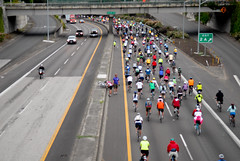
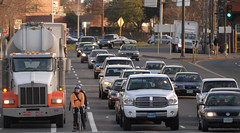
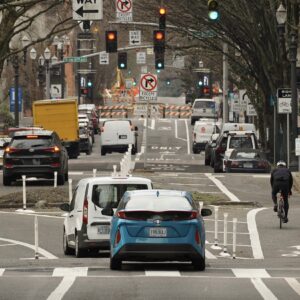
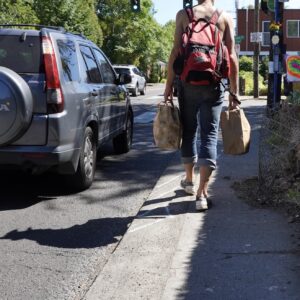
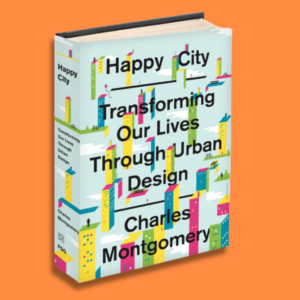
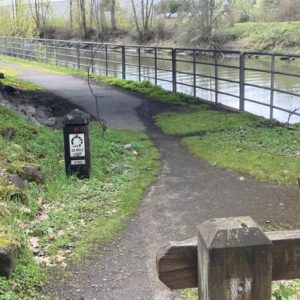
Thanks for reading.
BikePortland has served this community with independent community journalism since 2005. We rely on subscriptions from readers like you to survive. Your financial support is vital in keeping this valuable resource alive and well.
Please subscribe today to strengthen and expand our work.
As long as the city’s smartness isn’t proprietary (with IBM ownership of the intellectual property), sure.
Don’t know how you could build a “smarter” city than that pictured in the first photo illustration for this article. No supercomputer required, but I guess some folks just gotta have numbers in order to buy-in to the obvious. Excuse me now, gotta go count bikes…
Sounds like an excuse for someone to milk money out of someone else. Oh well.
Companies and city planners listen to data like this. Let’s hope it buys us more bike lanes, bike corrals, and in general a bigger share of the transportation funding!
“But, is it data analysis that will help our politicians and policymakers finally reach beyond the low-hanging fruit and tackle our big transportation problems?”
I doubt it. Though it depends on the kind of data under consideration.
We don’t lack data; we too often ask the wrong questions of the data we already have (my opinion). 1 in 6 households in Portland doesn’t own a car (2000 Census #s)–are we asking what they know and encouraging others to imitate or learn from them? No. Are we celebrating those who don’t rely on cars now? No. Are we curious about the potential for replicating the experiences of these households across the city? No. Are we taking these people into account when planning transportation projects, when modeling, when allotting funding? I doubt it? Why not? Will this oversight be changed by a supercomputer? I doubt it.
super computers = sexy
people who don’t have cars = not sexy
future of transportation = no cars
relevance of supercomputers = low
I’m very skeptical of the whole Big Gov-Big Corp “smart city” thing. Open source/Internet of Things/API social media type stuff like Pachube will be our best source for smart city creation. The real-time data and software/hardware will be open and it will be you and your friends sharing of that data that will make things and people smarter and influence infrastructure, not just a geek at IBM or someone like the mayor. We already do early versions of it here or on stuff like Map My Ride where we share information on routes, terrain, traffic, safety, etc. As the Pachube blog points out in one post, government has missed the boat on this one. Revolutions have been organized on Twitter and Facebook while the government is busy trying to connect garbage cans.
As for data to collect…one of the annually missed opportunities seems to be collecting air and noise quality data during (and before/ after) road closures for repairs and the car free events like Bridge Pedal and Sunday Parkways.
This data is critical in order to more correctly judge how our transportation investments/ infrastructure effects the quality of our neighborhoods – especially the low income areas frequently next to highways and major arterials.
Is anyone ready to do some sampling during the next Bridge Pedal?
Seems like something that Arduino, Pachube, or maybe SoundCloud might be good for.
Good news, I have completed my analysis of 20 years worth of data and have found that when it rains, the ground gets wetter.
Let’s hope IBM’s insights are a little more insightful and less obvious than their example.
ibm has done this before, with results… http://www.ibm.com/ibm/greateribm/connections/connections_article45.shtml. disclaimer: i work for ibm